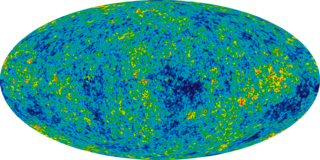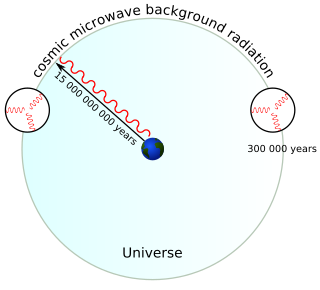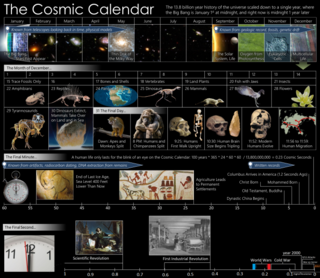Timeline

The scale is where is the time since the Big Bang expressed in years. For example, 10 billion years after the Big Bang (13.8 billion years ago) is .
This is the timeline of the Stelliferous era but also partly charts the Primordial era, and charts more of the Degenerate era of the heat death scenario.

The scale is where is the time since the Big Bang expressed in years. For example, 10 billion years after the Big Bang (13.8 billion years ago) is .

The Big Bang is a physical theory that describes how the universe expanded from an initial state of high density and temperature. The notion of an expanding universe was first scientifically originated by physicist Alexander Friedmann in 1922 with the mathematical derivation of the Friedmann equations. The earliest empirical observation of the notion of an expanding universe is known as Hubble's law, published in work by physicist Edwin Hubble in 1929, which discerned that galaxies are moving away from Earth at a rate that accelerates proportionally with distance. Independent of Friedmann's work, and independent of Hubble's observations, physicist Georges Lemaître proposed that the universe emerged from a "primeval atom" in 1931, introducing the modern notion of the Big Bang.

Olbers's paradox, also known as the dark night paradox or Olbers and Cheseaux's paradox, is an argument in astrophysics and physical cosmology that says the darkness of the night sky conflicts with the assumption of an infinite and eternal static universe. In the hypothetical case that the universe is static, homogeneous at a large scale, and populated by an infinite number of stars, any line of sight from Earth must end at the surface of a star and hence the night sky should be completely illuminated and very bright. This contradicts the observed darkness and non-uniformity of the night sky.

The ultimate fate of the universe is a topic in physical cosmology, whose theoretical restrictions allow possible scenarios for the evolution and ultimate fate of the universe to be described and evaluated. Based on available observational evidence, deciding the fate and evolution of the universe has become a valid cosmological question, being beyond the mostly untestable constraints of mythological or theological beliefs. Several possible futures have been predicted by different scientific hypotheses, including that the universe might have existed for a finite and infinite duration, or towards explaining the manner and circumstances of its beginning.

In physical cosmology, the Big Rip is a hypothetical cosmological model concerning the ultimate fate of the universe, in which the matter of the universe, from stars and galaxies to atoms and subatomic particles, and even spacetime itself, is progressively torn apart by the expansion of the universe at a certain time in the future, until distances between particles will infinitely increase.

The Big Crunch is a hypothetical scenario for the ultimate fate of the universe, in which the expansion of the universe eventually reverses and the universe recollapses, ultimately causing the cosmic scale factor to reach absolute zero, an event potentially followed by a reformation of the universe starting with another Big Bang. The vast majority of evidence, however, indicates that this hypothesis is not correct. Instead, astronomical observations show that the expansion of the universe is accelerating rather than being slowed by gravity, suggesting that a Big Freeze is much more likely to occur. Nonetheless, some physicists have proposed that a "Big Crunch-style" event could result from a dark energy fluctuation.

The heat death of the universe is a hypothesis on the ultimate fate of the universe, which suggests the universe will evolve to a state of no thermodynamic free energy, and will therefore be unable to sustain processes that increase entropy. Heat death does not imply any particular absolute temperature; it only requires that temperature differences or other processes may no longer be exploited to perform work. In the language of physics, this is when the universe reaches thermodynamic equilibrium.
A logarithmic timeline is a timeline laid out according to a logarithmic scale. This necessarily implies a zero point and an infinity point, neither of which can be displayed. The most natural zero point is the Big Bang, looking forward, but the most common is the ever-changing present, looking backward.

A cyclic model is any of several cosmological models in which the universe follows infinite, or indefinite, self-sustaining cycles. For example, the oscillating universe theory briefly considered by Albert Einstein in 1930 theorized a universe following an eternal series of oscillations, each beginning with a Big Bang and ending with a Big Crunch; in the interim, the universe would expand for a period of time before the gravitational attraction of matter causes it to collapse back in and undergo a bounce.

The horizon problem is a cosmological fine-tuning problem within the Big Bang model of the universe. It arises due to the difficulty in explaining the observed homogeneity of causally disconnected regions of space in the absence of a mechanism that sets the same initial conditions everywhere. It was first pointed out by Wolfgang Rindler in 1956.

In physical cosmology, the age of the universe is the time elapsed since the Big Bang. Astronomers have derived two different measurements of the age of the universe: a measurement based on direct observations of an early state of the universe, which indicate an age of 13.787±0.020 billion years as interpreted with the Lambda-CDM concordance model as of 2021; and a measurement based on the observations of the local, modern universe, which suggest a younger age. The uncertainty of the first kind of measurement has been narrowed to 20 million years, based on a number of studies that all show similar figures for the age. These studies include researches of the microwave background radiation by the Planck spacecraft, the Wilkinson Microwave Anisotropy Probe and other space probes. Measurements of the cosmic background radiation give the cooling time of the universe since the Big Bang, and measurements of the expansion rate of the universe can be used to calculate its approximate age by extrapolating backwards in time. The range of the estimate is also within the range of the estimate for the oldest observed star in the universe.
The expansion of the universe is parametrized by a dimensionless scale factor. Also known as the cosmic scale factor or sometimes the Robertson–Walker scale factor, this is a key parameter of the Friedmann equations.
A cosmological decade (CÐ) is a division of the lifetime of the cosmos. The divisions are logarithmic in size, with base 10. Each successive cosmological decade represents a ten-fold increase in the total age of the universe.
The heat death paradox, also known as thermodynamic paradox, Clausius' paradox, and Kelvin's paradox, is a reductio ad absurdum argument that uses thermodynamics to show the impossibility of an infinitely old universe. It was formulated in February 1862 by Lord Kelvin and expanded upon by Hermann von Helmholtz and William John Macquorn Rankine.

This timeline of the Big Bang shows a sequence of events as currently theorized.
This timeline lists events in the external environment that have influenced events in human history. This timeline is for use with the article on environmental determinism. For the history of humanity's influence on the environment, and humanity's perspective on this influence, see timeline of history of environmentalism. See List of periods and events in climate history for a timeline list focused on climate.

The expansion of the universe is the increase in distance between gravitationally unbound parts of the observable universe with time. It is an intrinsic expansion, so it does not mean that the universe expands "into" anything or that space exists "outside" it. To any observer in the universe, it appears that all but the nearest galaxies move away at speeds that are proportional to their distance from the observer, on average. While objects cannot move faster than light, this limitation applies only with respect to local reference frames and does not limit the recession rates of cosmologically distant objects.
This is a timeline of the Universe from the Big Bang to the heat death scenario. The different eras of the universe are shown. The heat death will occur in around 1.7×10106 years, if protons decay.

The Cosmic Calendar is a method to visualize the chronology of the universe, scaling its currently understood age of 13.8 billion years to a single year in order to help intuit it for pedagogical purposes in science education or popular science.

Current observations suggest that the expansion of the universe will continue forever. The prevailing theory is that the universe will cool as it expands, eventually becoming too cold to sustain life. For this reason, this future scenario popularly called "Heat Death" is also known as the "Big Chill" or "Big Freeze".

The chronology of the universe describes the history and future of the universe according to Big Bang cosmology.